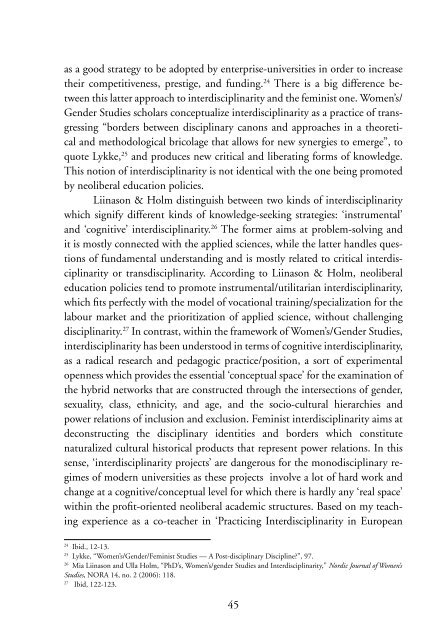Teaching with the third wave new feminists - MailChimp
Teaching with the third wave new feminists - MailChimp
Teaching with the third wave new feminists - MailChimp
Create successful ePaper yourself
Turn your PDF publications into a flip-book with our unique Google optimized e-Paper software.
as a good strategy to be adopted by enterprise-universities in order to increase<strong>the</strong>ir competitiveness, prestige, and funding. 24 There is a big difference betweenthis latter approach to interdisciplinarity and <strong>the</strong> feminist one. Women’s/Gender Studies scholars conceptualize interdisciplinarity as a practice of transgressing“borders between disciplinary canons and approaches in a <strong>the</strong>oreticaland methodological bricolage that allows for <strong>new</strong> synergies to emerge”, toquote Lykke, 25 and produces <strong>new</strong> critical and liberating forms of knowledge.This notion of interdisciplinarity is not identical <strong>with</strong> <strong>the</strong> one being promotedby neoliberal education policies.Liinason & Holm distinguish between two kinds of interdisciplinaritywhich signify different kinds of knowledge-seeking strategies: ‘instrumental’and ‘cognitive’ interdisciplinarity. 26 The former aims at problem-solving andit is mostly connected <strong>with</strong> <strong>the</strong> applied sciences, while <strong>the</strong> latter handles questionsof fundamental understanding and is mostly related to critical interdisciplinarityor transdisciplinarity. According to Liinason & Holm, neoliberaleducation policies tend to promote instrumental/utilitarian interdisciplinarity,which fits perfectly <strong>with</strong> <strong>the</strong> model of vocational training/specialization for <strong>the</strong>labour market and <strong>the</strong> prioritization of applied science, <strong>with</strong>out challengingdisciplinarity. 27 In contrast, <strong>with</strong>in <strong>the</strong> framework of Women’s/Gender Studies,interdisciplinarity has been understood in terms of cognitive interdiscipli narity,as a radical research and pedagogic practice/position, a sort of experimentalopenness which provides <strong>the</strong> essential ‘conceptual space’ for <strong>the</strong> examination of<strong>the</strong> hybrid networks that are constructed through <strong>the</strong> intersections of gender,sexuality, class, ethnicity, and age, and <strong>the</strong> socio-cultural hierarchies andpower relations of inclusion and exclusion. Feminist interdisciplinarity aims atdeconstructing <strong>the</strong> disciplinary identities and borders which constitutenaturalized cultural historical products that represent power relations. In thissense, ‘interdisciplinarity projects’ are dangerous for <strong>the</strong> monodisciplinary regimesof modern universities as <strong>the</strong>se projects involve a lot of hard work andchange at a cognitive/conceptual level for which <strong>the</strong>re is hardly any ‘real space’<strong>with</strong>in <strong>the</strong> profit-oriented neoliberal academic structures. Based on my teachingexperience as a co-teacher in ‘Practicing Interdisciplinarity in European24Ibid., 12-13.25Lykke, “Women’s/Gender/Feminist Studies — A Post-disciplinary Discipline?”, 97.26Mia Liinason and Ulla Holm, “PhD’s, Women’s/gender Studies and Interdisciplinarity,” Nordic Journal of Women’sStudies, NORA 14, no. 2 (2006): 118.27Ibid, 122-123.45
















